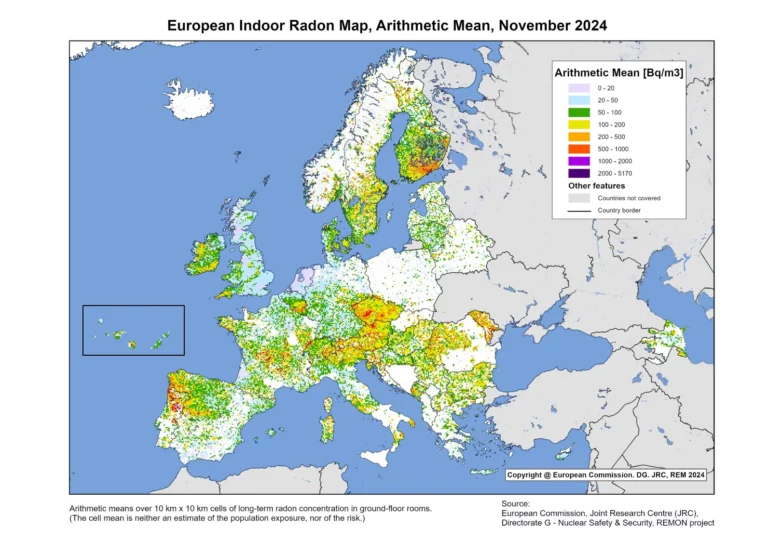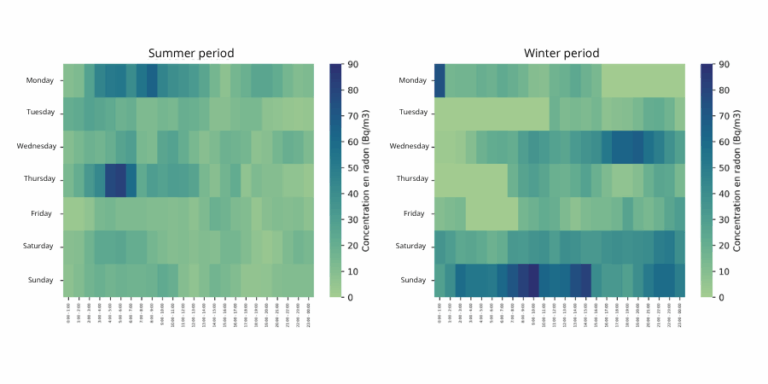BLOG
While indoor air quality (IAQ) is a critical issue in all buildings, some face specific challenges. This is particularly the case for structures located in areas with high radon potential: this radioactive gas from soils can infiltrate buildings and pose a risk to the health of occupants.
As a result, some institutions in the high-risk areas that are open to the public must meet strict regulatory requirements. This is particularly the case of schools, which are all the more concerned since they welcome a fragile public.
A good understanding of radon emission and transport dynamics is essential. It is in this context that we intervened in a French nursery school in the city of Limoges to implement a ventilation strategy adapted to the radon risk.
Air pollution is likely to have serious health consequences. It can cause respiratory problems, even in the most serious cases, cardiovascular pathologies or cancers.
For some categories of people whose health is more fragile, the consequences can be even greater. Children in particular, whose respiratory and immune systems are developing, are particularly vulnerable to poor IAQ.
Among the pollutants that can affect health, radon poses a particular risk. It is now the second cause of lung cancer after smoking and accounts for 10% of deaths related to this pathology.
Also, the likelihood of radon-related lung cancer increases with concentration and duration of exposure. Thus, according to the WHO, the risk would increase by 16% for every 100 Bq/m3 increase over a period of 30 years.
If radon dissipates quickly in the outside air, its concentration can increase significantly in confined spaces, posing a health hazard to occupants. For this reason, it is subject to special regulations in certain establishments receiving the public, such as schools and nurseries.

Radon concentrations can vary considerably from country to country, leading to different regulations depending on the areas. We can see this with the example of Europe.
Radon levels are colour coded based on measured concentration:
According to the World Health Organization (WHO), the reference value for radon concentration should not exceed 100 becquerels per cubic meter (Bq/m³). However, this level is difficult to reach in certain countries due to the nature of the soil, so a tolerance threshold of 300 Bq/m³ has been set.
In countries with varying radon levels, buildings in high-risk areas (such as those with radon concentrations above 300 Bq/m³) are required to implement radon risk management measures to reduce concentrations. For buildings in low-risk or moderate-risk zones, action is required only if previous measurements exceed 300 Bq/m³. If radon levels surpass this threshold, corrective measures must be taken to ensure the safety and health of occupants.
It is in this context that the French city of Limoges has called on Octopus Lab. Limoges naturally has a high radon concentration. In order to ensure good IAQ within the nursery school, a maximum concentration threshold was set at 100 Bq/m3.
To achieve this objective, the implementation of intelligent and predictive ventilation management, based in particular on radon, has proved to be the most appropriate solution.
The aim here was to anticipate radon peaks in order to adapt the operation of the air-treatment plant and to maintain a concentration below the threshold of 100 Bq/m3. In this way, it is possible to minimize the exposure of occupants and preserve their health.
The volume activity of radon in air depends on many factors. It is influenced by the geological properties of the ground (porosity, uranium concentration…) as well as by environmental factors such as altitude and weather conditions (temperature, humidity, precipitation, wind…). These variations are particularly evident in winter when the difference between indoor and outdoor pressures is conducive to the infiltration of radon into buildings.
Understanding these fluctuations is essential to anticipate the radon concentration and thus propose an adapted ventilation profile for the next few hours. Continuous measurements were therefore carried out for a year in three classrooms of the school. For this, the rooms were equipped with a Spirit Radon sensor developed by Radonova.

With more than 30 years of experience, Radonova is today the world leader in radon measurement.
Operating in more than 80 countries around the world, the laboratory designs and distributes radon detectors that are known for their reliability and accuracy.
Radonova is also involved in supporting and raising awareness of radon, thus actively participating in improving indoor air quality.
Measurements reveal high emission rates associated with significant variations during the winter period. Conversely, during the summer, emissions are generally lower and stable.

Radon concentration in the building over one week, averaged over three months of winter (left graph) and three months of summer (right graph).
Due to the large fluctuations, predicting future radon concentrations within a facility can be challenging. In order to define an effective control profile, it is therefore essential that the predictive model be able to anticipate these variations and the concentration peaks reported by the sensors.
The data collected was integrated into a 3D digital twin of the facility including its technical characteristics, particulary the ventilation system.
Created with INDALO®, our IAQ simulation software, this model is connected to meteorological and environmental databases in order to include external parameters (humidity, temperature, pollution…).
The digital twin is then integrated into INDALO® Supervision, a predictive control solution for HVAC equipment. The software then uses artificial intelligence coupled with a calculation engine dedicated to indoor air chemistry to model the interactions between radon sources in the soil, external conditions and indoor air parameters.
INDALO® Supervision is able to predict radon concentrations and other pollutants over a 24-hour period. The forecast is updated hourly based on new data measured in real time.
The reliability of predictions was assessed by calculating the root-mean-square error (RMSE). This operation consists of estimating the differences between forecast values (here formulated by INDALO® Supervision) and actually measured values.
Here, the RMSE averages 50 Bq/m3 while the sensor uncertainty in this concentration range is +/- 10 Bq/m 3. Thus, the predictive model and sensors produce deviations of the same order of magnitude.
This demonstrates a good representativeness of the simulations in relation to the measurements: the model succeeds in correctly reproducing the general trends of concentration variations, even in winter when fluctuations are more important.
These results highlight the robustness of the digital twin to accurately capture the influence of seasonality on radon emissions and model the complex dynamics of radon within the building. They confirm the ability of INDALO® Supervision to provide reliable forecasts, enabling optimized ventilation management to effectively reduce radon exposure while minimizing energy consumption.
The implementation of our intelligent control of ventilation based on radon has allowed us to maintain an average concentration of 60 Bq/ m 3. It therefore meets the regulatory requirements and the objectives set with the city of Limoges.
These results confirm the importance of anticipating emissions specific to buildings and their environment, especially in areas with specific pollution. In this context, the accuracy of forecasts and the ability to adjust air renewal rates in real time are two key points.
Finally, it is worth noting that the use of the digital twin offers great flexibility. Through the integration of local environmental databases within the solution, it is possible to take into account the specificities of each building. This allows the operation of ’INDALO® Supervision to be adapted to territories where issues differ, for example with low radon levels but high outdoor pollution.
| Note: adjusting the air renewal to actual needs allows a significant reduction in energy consumption related to ventilation operation. In the case of this French school, which has a surface area of about 300 m2, the earnings amount to € 2,425 per year.

Bonjour ! C'est nous, les cookies 🍪
Nous sommes chargés de compter le nombre de visites sur ce site internet. Nous aidons énormément les personnes qui travaillent ici, car nous leur permettons d'améliorer le contenu du site internet mais aussi de rendre votre visite plus agréable.